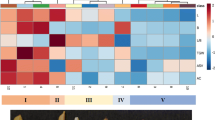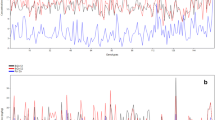Abstract
Neutron activation analysis (NAA) was used for determining chemical elements in rice grains of four different cultivars (IRGA424, IRGA424 RI, Guri Inta, Puitá Inta) produced in four geographic regions of Rio Grande do Sul state, Brazil. Considering toxic elements, As varied from 0.027 to 0.646 mg/kg, while Cd was always lower than the detection limit of 0.25 mg/kg. Applying principal component and cluster analysis, As, Br, Co, Cs, Na, Rb and Zn presented potential to be used to distinguish rice grains from different regions, while no discrimination was obtained amongst cultivars.





Similar content being viewed by others
References
Sohn E (2014) The toxic side of rice. Nature 514:62–63
FAO (Food and Agriculture Organization) (2016) Food and agricultural commodities production: rice paddy-top 10 countries. http://www.fao.org/faostat/en/#data/QC. Accessed 30 May 18
CONAB (2018) Séries históricas: arroz safra 2017/2018. http://www.conab.gov.br/conteudos.php?a=1252&t=. Accessed 07 Mar 2018
MDIC. Ministry of industry, foreign trade and services. http://www.mdic.gov.br/comercio-exterior/estatisticas-de-comercio-exterior/comex-vis/frame-ppe?ppe=104. Accessed 8 May 2018
Zhao FJ, Ma JF, Meharg AA, MCgrath SP (2009) Arsenic uptake and metabolism in plants. New Phytol 181:777–794
Souza JMO, Carneiro MF, Paulelli ACC, Grotto D, Magalhães AM Jr, Barbosa F Jr, Batista BL (2015) Arsenic and rice: toxicity, metabolism, and food safety. Quim Nova 38:118–127
Zhao FL, Zhu YG, Meharg AA (2013) Methylated arsenic species in rice: geographical variation, origin, and uptake mechanisms. Environ Sci Technol 47:3957-3966
Duxbury JM, Panaullah G (2007) Remediation of arsenic for agriculture sustainability, food security and health in Bangladesh. FAO Water Report, p 28
Kuramata M, Abe T, Kawasaki A, Ebana K, Shibaya T, Yano M, Satoru I (2013) Genetic diversity of arsenic accumulation in rice and QTL analysis of methylated arsenic in rice grains. Rice 6:3
Williams PN, Villada A, Deacon C, Raab A, Figuerola J, Green AJ, Feldmann J, Meharg AA (2007) Greatly enhanced arsenic shoot assimilation in rice leads to elevated grain levels compared to wheat and barley. Environ Sci Technol 41:6854–6859
Duker AA, Carranza EJM, Hale M (2005) Arsenic geochemistry and health. Environ Int 31:631–641
International Agency for Research on Cancer-IARC (2012) Monographs on the evaluation of carcinogenic risks to humans: arsenic, metals, fibers and dusts. http://monographs.iarc.fr/ENG/Monographs/vol100C/mono100C.pdf>. Accessed 17 Jan 2017
ANVISA (Brazillian Health Regulatory Agency) (2013). http://portal.anvisa.gov.br/documents/33880/2568070/rdc0042_29_08_2013.pdf/c5a17d2d-a415-4330-90db-66b3f35d9fbd. Accessed 20 May 2018
Zavala YJ, Gerads R, Gorleyok H, Duxbury JM (2008) Arsenic in rice: II. Arsenic speciation in USA grain and implications for human health. Environ Sci Technol 42:3861–3866
Liu WJ, Zhu YG, Hu Y, Williams PN, Gault AG, Meharg AA, Charnock JM, Smith FA (2006) Arsenic sequestration in iron plaque, its accumulation and speciation in mature rice plants (Oryza sativa L.). Environ Sci Technol 40:5730–5736
Norton GJ, Duan G, Dasqupta T, Islam MR, Lei M, Zhu YG, Deacon CM, Moran AC, Islam S, Zhao FJ, Stroud JL, Mcgrath SP, Feldmann J, Price AH, Meharg AA (2009) Environmental and genetic control of arsenic accumulation and speciation in rice grain: comparing a range of common cultivars grown in contaminated sites across Bangladesh, China and India. Environ Sci Technol 43:8381–8386
Mitra A, Chatterjee S, Moogouei R, Gupta DK (2017) Arsenic accumulation in rice and probable mitigation approaches: a review. Agronomy 7:67
Meharg AA, Zhao FJ (2012) Strategies for producing low arsenic rice. In: Meharg AA, Zhao FJ (eds) Arsenic & Rice. Springer, Dordrecht
Li R, Stroud JL, Ma JF, McGrath SP, Zhao FJ (2009) Mitigation of arsenic accumulation in rice with water management and silicon fertilization. Environ and Sci Technol 43:3778–3783
Jayasekera R, Freitas MC (2005) Concentration levels of major and trace elements in rice from Sri Lanka as determined by the k0 standardization method. Biol Trace Elem Res 2005 103:83–96
Kato LS, Fernandes EAN, Bacchi MA, Elias C, Sarriés SRV, Sarriés GA, Modolo PS (2013) Instrumental neutron activation analysis for assessing homogeneity of a whole rice candidate reference material. J Radioanal Nucl Chem 297:271–275
Badza S, Jevremovic T (2014) Neutron activation analysis of Californian and Japanese rice. J Radioanal Nucl Chem 299:427
França EJ, Fernandes EAN, Bacchi MA (2003) Ni-Cr alloy as neutron flux monitor: composition and homogeneity assessment by NAA. J Radioanal Nucl Chem 257:113–115
Bacchi MA, Fernandes EAN, Oliveira HA (2000) Brazilian experience on k0 standardized neutron activation analysis. J Radioanal Nucl Chem 245:217-222
Montgomery DC (1997) In: Montgomery DC (ed) Chapter 5. Introduction to factorial designs design and analysis of experiments. Wiley
Bewick V, Cheek L, Ball J (2004) Statistics review 9: One-way analysis of variance. Crit Care 8:130–136
Rocha F, Vale NM, Barili LD, Coimbra JLM, Guidolin AF, Bertoldo JG (2012) An approach to the decomposition of interaction in a factorial experiment with five factors. Acta Sci Agron 34:51–59
Granato D, Calado VMA, Jarvis B (2014) Observations on the use of statistical methods in food science and technology. Food Res Int 55:137–149
Xue J, Lee C, Wakeham SG, Armstrong RA (2011) Using principal components analysis (PCA) with cluster analysis to study the organic geochemistry of sinking particles in the ocean. Org Geochem 42:356–367
Jolliffe T, Cadima J (2016) Principal component analysis: a review and recent developments. Phil Trans R Soc 374:20150202
ISO (International Organization for Standardization) (2015) ISO Guide 13528 Statistical methods for use in proficiency testing by interlaboratory comparisons. ISO, Geneva
Masson P, Dalix T, Bussière S (2010) Determination of major and trace elements in plant samples by inductively coupled plasma–mass spectrometry. Commun Soil Sci Plan 41:231–243
Kamenik J, Kucera J (2015) Discrepancy of sodium mass fraction determined by INAA in the NIST SRM1547 and SRM1515 reference materials and their certified values. Proceedings of the workshop on radioanalytical methods 'IAA 14'. https://inis.iaea.org/search/search.aspx?orig_q=source:%22ISBN%20978-80-905704-4-3%22. Accessed 10 Aug 2018
Poletti J, Pozebon D, Fraga MVB, Dressler VL, Moraes DP (2014) Toxic and micronutrient elements in organic, brown and polished rice in Brazil. Food Addit Contam B 7:63–69
Mataveli LRV, Buzzo ML, Arauz LJ, Carvalho MFH, Arakaki EEK, Matsuzaki R, Tiglea P (2016) Total arsenic, cadmium, and lead determination in Brazilian rice samples Using ICP-MS. J Anal Methods Chem 2016:1–9
Acknowledgements
The authors wish to thank the National Council for Scientific and Technological Development (CNPq) for the financial support.
Author information
Authors and Affiliations
Corresponding author
Rights and permissions
About this article
Cite this article
Kato, L.S., De Nadai Fernandes, E.A., Bacchi, M.A. et al. Elemental composition of Brazilian rice grains from different cultivars and origins. J Radioanal Nucl Chem 318, 745–751 (2018). https://doi.org/10.1007/s10967-018-6122-8
Received:
Published:
Issue Date:
DOI: https://doi.org/10.1007/s10967-018-6122-8




